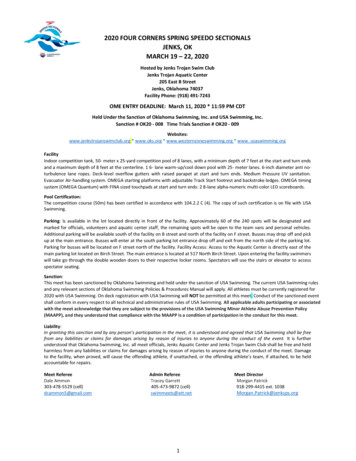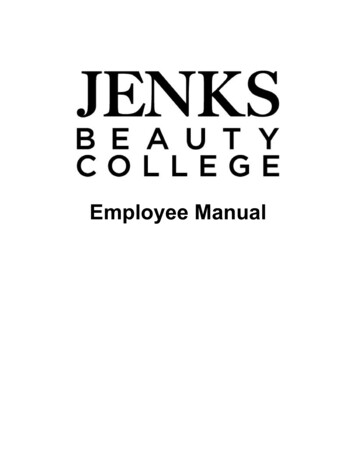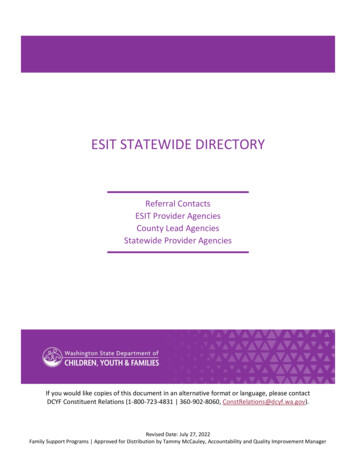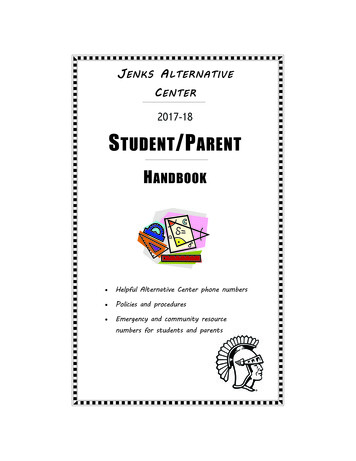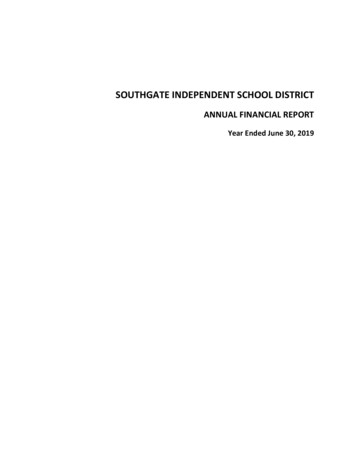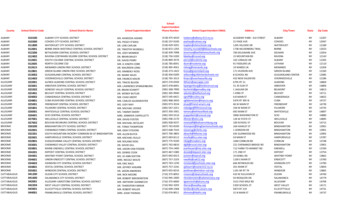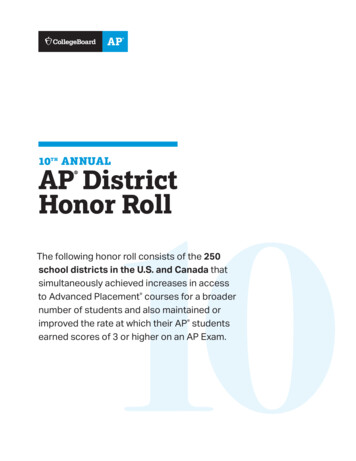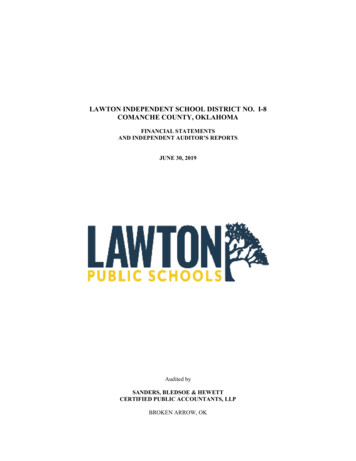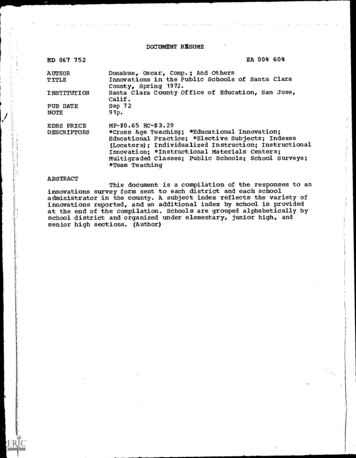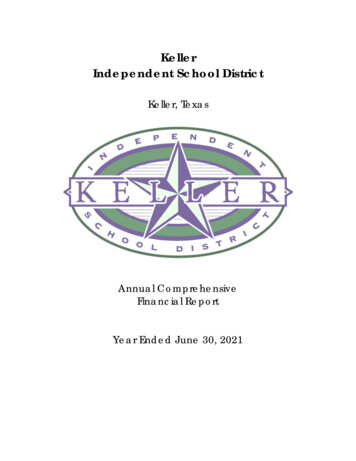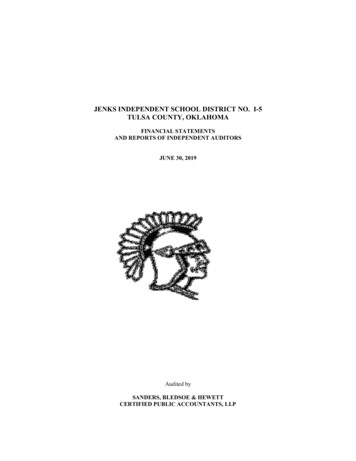
Transcription
JENKS INDEPENDENT SCHOOL DISTRICT NO. I-5TULSA COUNTY, OKLAHOMAFINANCIAL STATEMENTSAND REPORTS OF INDEPENDENT AUDITORSJUNE 30, 2019Audited bySANDERS, BLEDSOE & HEWETTCERTIFIED PUBLIC ACCOUNTANTS, LLP
BROKEN ARROW, OKJENKS INDEPENDENT SCHOOL DISTRICT NO. I-5TULSA COUNTY, OKLAHOMASCHOOL DISTRICT OFFICIALSJUNE 30, 2019BOARD OF EDUCATIONPresidentChuck ForbesVice-PresidentTracy KennedyMembersRon BarberTerry KeelingMelissa AbdoClerk of BoardKim BourkeSUPERINTENDENT OF SCHOOLSDr. Stacey ButterfieldCHIEF FINANCIAL OFFICER/TREASURERCody Way
www.jenksps.orgJENKS INDEPENDENT SCHOOL DISTRICT NO. I-5TULSA COUNTY, OKLAHOMAJUNE 30, 2019TABLE OF CONTENTSPageIndependent Auditor’s Report1Management’s Discussion and Analysis3Government-Wide Financial Statements:Statement of Net Position7Statement of Activities8Fund Financial Statements:Statement of Assets, Liabilities and Cash Fund Balances– Governmental FundsStatement of Revenues, Expenditures and Changes in CashFund Balances – Governmental FundsReconciliation of the Statement of Revenues, Expendituresand Changes in Fund Balances of Governmental Fundsto the Statement of ActivitiesStatement of Fiduciary Net PositionNotes to Financial Statements910111213Required Supplementary Information:Budgetary Comparison Schedule – General Fund32Budgetary Comparison Schedule – Building Fund33Budgetary Comparison Schedule – Child Nutrition Fund34Budgetary Comparison Schedule – Sinking Fund35Budgetary Comparison Schedule – Bond Funds36Other Supplementary Information:Combining Statement of Assets, Liabilities and Fund Balance– All Capital Projects Funds – Regulatory Basis37
JENKS INDEPENDENT SCHOOL DISTRICT NO. I-5TULSA COUNTY, OKLAHOMAJUNE 30, 2019PageCombining Statement of Revenues Collected, Expenditures andChanges in Cash Fund Balances – All Capital Projects Funds– Regulatory Basis38Combining Statement of Assets, Liabilities and Fund Balance– All Fiduciary Fund Types – Regulatory Basis39Combining Statement of Revenues Collected, Expenditures andChanges in Cash Fund Balances – Expendable Trust Fund Types – Regulatory Basis40Combining Statement of Changes in Assets and Liabilities– Agency Funds – Regulatory Basis41Supporting Schedules and Reports Required by Government Auditing Standards:Schedule of Expenditures of Federal Awards – Regulatory Basis46Independent Auditor’s Report on Internal Control over FinancialReporting and on Compliance and Other Matters Basedon an Audit of Financial Statements - Regulatory Basis –Performed in Accordance with Government Auditing Standards48Independent Auditor’s Report on Compliance with RequirementsApplicable to each Major Program and Internal Control overCompliance in Accordance with Uniform Guidance50Disposition of Prior Year’s Significant Deficiencies andMaterial Instances of Non-Compliance52Schedule of Findings and Responses53Schedule of Statutory, Fidelity and Honesty Bonds54Schedule of Accountant’s Professional Liability Insurance Affidavit55
INDEPENDENT AUDITOR’S REPORTThe Honorable Board of EducationJenks School District Number I-5Jenks, Tulsa County, OklahomaReport on the Financial StatementsWe have audited the accompanying combined fund type and account group financial statements – regulatory basis of the JenksSchool District Number I-5, Jenks, Tulsa County, Oklahoma (the District), as of and for the year ended June 30, 2019, and therelated notes to the financial statements, which collectively comprise the District’s basic financial statements as listed in thetable of contents.Management’s Responsibility for the Financial StatementsManagement is responsible for the preparation and fair presentation of these financial statements in accordance with financialreporting provisions of the Oklahoma State Department of Education to meet financial reporting requirements of the State ofOklahoma; this includes determining that the regulatory basis of accounting is an acceptable basis for the preparation of thefinancial statements in the circumstances. Management is also responsible for the design, implementation, and maintenance ofinternal control relevant to the preparation and fair presentation of financial statements that are free from materialmisstatement, whether due to fraud or error.Auditor’s ResponsibilityOur responsibility is to express an opinion on these financial statements based on our audit. We conducted our audit inaccordance with auditing standards generally accepted in the United States of America, and the standards applicable tofinancial audits contained in Government Auditing Standards, issued by the Comptroller General of the United States. Thosestandards require that we plan and perform the audit to obtain reasonable assurance about whether the financial statements arefree from material misstatement.An audit involves performing procedures to obtain audit evidence about the amounts and disclosures in the financialstatements. The procedures selected depend on the auditor’s judgment, including the assessment of the risks of materialmisstatement of the financial statements, whether due to fraud or error. In making those risk assessments, the auditor considersinternal control relevant to the entity’s preparation and fair presentation of the financial statements in order to design auditprocedures that are appropriate in the circumstances, but not for the purpose of expressing an opinion on the effectiveness ofthe entity’s internal control. Accordingly, we express no such opinion. An audit also includes evaluating the appropriatenessof accounting policies used and the reasonableness of significant accounting estimates made by management, as well asevaluating the overall presentation of the financial statements.We believe that the audit evidence we have obtained is sufficient and appropriate to provide a basis for our audit opinions.Basis for Adverse Opinion on U.S. Generally Accepted Accounting PrinciplesAs discussed in Note 1, the financial statements are prepared by the District, on the basis of the financial reporting provisionsof the Oklahoma State Department of Education, which is a basis of accounting other than accounting principles generallyaccepted in the United States of America, to comply with the requirements of the Oklahoma State Department of Education.The effects on the financial statements of the variances between the regulatory basis of accounting described in Note 1 andaccounting principles generally accepted in the United States of America, although not reasonable determined, are presumed tobe material.1
Adverse Opinion on U.S. Generally Accepted Accounting PrinciplesIn our opinion, because the significance of the matter discussed in the “Basis for Adverse Opinion on U.S. Generally AcceptedAccounting Principles” paragraph, the financial statements referred to in the first paragraph do not present fairly, in accordancewith accounting principles generally accepted in the United States of America, the financial position of the District as of June30, 2019, the changes in its financial position, or, where applicable, its cash flows for the year then ended.Unmodified Opinion on Regulatory Basis of AccountingIn our opinion, the financial statements referred to in the first paragraph present fairly, in all material respects, the assets,liabilities and fund balance arising from regulatory basis transactions of each fund type and account group of the District, as ofJune 30, 2019, and the revenues collected and expenditures paid and encumbered for the year then ended on the regulatorybasis of accounting described in Note 1.Other MattersOur audit was conducted for the purpose of forming opinions on the financial statements that collectively comprise theDistrict’s basic financial statements. The combining statements – regulatory basis, are presented for purposes of additionalanalysis and are not a required part of the basic financial statements. The schedule of expenditures of federal awards ispresented for purposes of additional analysis as required by Title 2 U.S. Code of Federal Regulations (CFR) Part 200, UniformAdministrative Requirements, Cost Principles, and Audit Requirements for Federal Awards, and is also not a required part ofthe basic financial statements.The combining statements – regulatory basis and the schedule of expenditures of federal awards are the responsibility ofmanagement and were derived from and relate directly to the underlying accounting and other records used to prepare the basicfinancial statements. Such information has been subjected to the auditing procedures applied in the audit of the basic financialstatements and certain additional procedures, including comparing and reconciling such information directly to the underlyingaccounting and other records used to prepare the basic financial statements or to the basic financial statements themselves, andother additional procedures in accordance with auditing standards generally accepted in the United States of America. In ouropinion, the combining statements – regulatory basis and the schedule of expenditures of federal awards are fairly stated in allmaterial respects in relation to the basic financial statements as a whole.The management’s discussion and analysis and the budgetary comparison information on pages 3 through 6 and 32 through36, respectively, are not a required part of the basic financial statements but are supplementary information required byaccounting principles generally accepted in the United States. We have applied certain limited procedures, which consistedprincipally of inquiries of management regarding the methods of measurement and presentation of the required supplementaryinformation. However, we did not audit the information and express no opinion on it.Other Reporting required by Government Auditing StandardsIn accordance with Government Auditing Standards, we have also issued our report dated January 10, 2020 on ourconsideration of the District’s internal control over financial reporting and on our tests of its compliance with certain provisionsof laws, regulations, contracts and grant agreements and other matters. The purpose of that report is to describe the scope ofour testing of internal control over financial reporting and compliance and the results of that testing, and not to provide anopinion on the internal control over financial reporting or on compliance. That report is an integral part of an audit performedin accordance with Government Auditing Standards in considering the District’s internal control over financial reporting andcompliance.Sanders, Bledsoe & HewettCertified Public Accountants, LLPJanuary 10, 20202
Independent School District No. 5 Tulsa County, OklahomaJenks Public SchoolsManagement’s Discussion and AnalysisFiscal Year Ending June 30, 2019Jenks Public Schools provides this discussion and analysis of the District’s financial activities for fiscal year (FY)ending June 30, 2019. The intent of this narrative overview is to look at the District’s financial performance.Readers are encouraged to consider the notes to the basic financial statements to enhance their understandingof Jenks Schools' financial performance. This is the 16th year the District has prepared financial statementsfollowing Governmental Accounting Standards Board (GASB) Statement No. 34 presentation.Fund Financial StatementsThis annual report consists of a series of financial statements. The governmental-wide statements include theStatement of Net Assets and Statement of Activities, which provide information about the activities of the entireDistrict, presenting both an aggregate view of the District’s finances and a long-term view of those finances.The District uses many funds to account for a multitude of financial transactions. A fund is a grouping of relatedaccounts that is used to maintain control over resources that have been segregated for specific activities orobjectives. The District uses fund accounting to ensure and demonstrate compliance with financial-related legalrequirements. The fund financial statements focus on the individual segments of the District’s operations inmore detail than government-wide financial statements. Because the focus of District funds is more narrow thanthe government-wide financial statements, it is useful to compare the information presented for District fundswith similar information presented for District activities in the government-wide financial statement. Both theDistrict’s fund balance statement and the District’s fund statement of revenues, expenditures, and changes infund balance provide a reconciliation to facilitate this comparison between funds and activities of each.Funds are classified into three categories: governmental, proprietary, and fiduciary with each category dividedinto separate “fund types.” Governmental funds include General Fund, Building Fund, Child Nutrition Fund,Sinking Fund, and Bond Fund. The District did not operate any proprietary funds, which use the same basis ofaccounting as “business-type” activities in the private sector. Fiduciary funds are used to account for assetsheld on behalf of outside parties, including other governments, or on behalf of other funds within the District, andinclude, but are not limited to, PTAG (Parent/Teacher Association Group), Booster Clubs, Arbitrage, WorkersCompensation, School Student Activity Groups, and Community Education.General Fund HighlightsThe General Fund is the largest single governmental fund and comprises 70.64% of the total District revenue.This fund represents most of the District’s day-to-day operational expenses. At the close of FY 2019, theDistrict reported positive cash balances in all funds with the General Fund balance being 6,618,999 which is apercentage balance of 7.20% of revenue received for this fund. The Oklahoma Legislature approved a largeteacher salary increase for FY 2019 which directly impacted the General Fund Budget. The Jenks PublicSchools Board of Education and Administration have worked diligently to enhance and protect the fund balancereserves in order to address future revenue reductions. In 2010, the Board of Education designated 8% as theDistrict’s fund balance goal. With all new revenue tied to the mandated salary increases, there was minimalflexibility in the budgeting process to meet the 8% Fund Balance target for FY 2019. For the first time since2010, the District did not to meet its fund balance objective. However, the ending fund balance of 7.2% stillleaves the District in a strong financial position.Fund BalancesAs of the close of FY 2019, the District reported a governmental-wide ending cash fund balance of 59,279,256,reflecting an increase of 3,096,989 or 5.52% in comparison with the prior year. The General Fund’s endingbalance decreased by 154,301 due to increased costs to mandated teacher salary increase and costs toaddress a growing student enrollment. Individual fund balances for the Child Nutrition Fund, Sinking Fund, andBond Funds increased in comparison with the prior year. The District’s Bond Funds represented the largestcash fund balance increase with a growth of 2,446,156.3
Fund Type2018 Fund Balance2019 Fund BalanceVariancePercentGeneral 6,773,300 6,618,999- 154,301-2.28%Building 403,976 203,742- 200,234-49.57% 1,035,042 1,125,367 90,3258.73%Sinking 13,931,671 14,898,643 966,9716.94%Bond 33,950,502 36,396,658 2,446,1567.21%Other 87,776 35,847- 51,929-59.16%Total 56,182,268 59,279,256 3,096,9895.52%Child NutritionFiscal Year 2019 SummaryGeneral Fund revenue collections for the fiscal year ending June 30, 2019, totaled 91,587,541, reflecting a netgain of 2,713,817 from the original estimated General Fund revenue projections of 88,873,724 approved andadopted by the Board of Education in June 2018. The increase in revenue was a result of growth in the netassessed property valuation within the District, an increase in the state dedicated collections, and an increasestate aid revenue due to an increase in the per pupil factor. District General Fund operating expenses totaled 92,122,230, which was an increase of 3,502,622 over the initial adopted budget of 88,619,608. This includedsalary increases, purchases for classroom supplies and equipment, increased operational expenses with thenewly opened facilities, and additional positions to address the needs of the District’s increasing studentenrollment.The internal controls, policies, and procedures relating to the financial operations of the District remained strong.The FY 2019 audit reflects an unqualified opinion issued on the financial statements. The audit discloses noreportable conditions in the internal controls. The audit notes no reportable instance of noncompliance will bereported in accordance with GAGAS. The audit discloses no reportable conditions in the internal controls overmajor federal programs. An unqualified opinion was issued on the compliance of major programs. The auditdiscloses no findings which would require to be reported under OMB Circular A-133 section 510(a). (See page53 of audit under the summary of audit results.)Long Term DebtGeneral Obligation Bonds: As of June 30, 2019, the District had 94,675,000 in outstanding bonds and notescompared to 90,070,000 on June 30, 2018. During FY 2019, the District retired 24,565,000 in bonds and/ornotes and added 29,170,000 in long-term debt.Fiscal YearBonds IssuedOutstandingFinal Payment2015 Series 23,680,000 5,980,0006-01-20202016 Series 24,990,000 12,500,0006-01-20212017 Series 24,660,000 18,495,0006-01-20222018 Series 28,530,000 28,530,0006-01-20232019 Series 29,170,000 29,170,0006-01-2024 131,030,000 94,675,000TotalInterest paid on general long-term debt during the fiscal year ending June 30, 2019, totaled 2,413,112.Lease Revenue Bonds: Initially, the Tulsa County Industrial Authority issued 104,420,000 of EducationalFacilities Lease Revenue Bonds for Jenks Public Schools to provide funds required for the constructing,equipping, repairing and remodeling of school buildings; acquiring school furniture, fixtures, and equipment; aswell as acquiring and improving school sites for the benefit of Jenks Public Schools. On July 1, 2009, the4
District, as lessor, entered into a ground lease agreement for certain district property, with the Tulsa CountyIndustrial Authority. In addition, the District entered a sublease, as lessee, with the Tulsa County IndustrialAuthority. The sublease called for eleven (11) annual payments with the initial payment made on September11, 2010. These acquisition payments will be made from General Obligation bond funds, pursuant to theissuance of series bonds in the amount of 153,430,000, voted on and approved by the patrons of Jenks PublicSchools on December 9, 2008. Jenks Public Schools will gain ownership to the capital improvementsincrementally as each payment is made.As of June 30, 2017, all projects associated with the 2009 Lease Revenue Bond have been completed with atotal cost of construction of 106,135,259.On February 10, 2015, voters approved another Educational Facilities Lease Revenue Bond in the amount of 83,725,000. Proceeds associated with this bond were received during FY 2016. Construction projectscompleted during FY 2019 were the Middle School Classroom Expansion and High School Renovation andAddition Phase III.Capital and Fixed AssetsThe District is in its 16th year of tracking all assets of significant value. The District’s fixed asset inventoryprocess requires equipment, furniture and fixtures, new construction and remodeled buildings and land beupdated annually with inventory software monitored through the Purchasing and Warehouse Departments.Building structures and improvements are added to the inventory as projects are completed and space isoccupied. For the year ending June 30, 2019, capital assets are as follows:BeginningIncreases/DecreasesEndingCapital Assets 391,035,142 39,890,316 430,438,500Depreciation( 80,167,820)( 12,716,854)( 92,397,716)Total Capital Assets 310,867,322 27,173,462 338,040,784Fiscal Year 2020 ForecastIn 2019, the Oklahoma state legislature provided the first tax increase in 28 years. It was also the largest taxincrease in state history while providing funding for the largest-ever teacher pay increase. Common Education’sappropriation grew by an additional 480 million which included salary increases for certified and supportpersonnel along with additional funding for health insurance and instructional materials. For FY 2020, thelegislature also approved an additional teacher increase along with some operational funding. With a growingstatewide student population, increased operational funding to reduce class size will continue to be a request toour state leaders. Current statewide collections are above prior year levels, yet data reflects growth may beslowing down. This will certainly challenge the legislature to find additional funding to craft the FY 2021 budget.Property values continue to rise as the local net assessed valuation (NAV) increased at a rate of 2.73%.Residential housing starts and commercial development continue within the Jenks Public School District.Although student growth increased by approximately 336 students for FY 2018 and 180 students for FY 2019,the District only gained 64 students for FY 2020. While enrollment fluctuations present challenges, the Districtcontinues to maintain a strong financial position.As we move through FY 2020, Jenks Public Schools will likely continue to face financial challenges. TheDistrict’s Board of Education has placed a very high priority on maintaining the District’s fund balance at afiscally responsible level. Therefore, the General operating budget is continuously monitored to ensure completealignment of expenses with available revenue. The budget is amended once the District has received one ormore of the following: An accurate District “Net Assessed Valuation” certified by the Board of EqualizationCertified and audited prior year actual collected revenuesFinal Federal grant award notifications for FY 2020 programsAny increased State dedicated revenuesOctober child count conducted by the State regional accreditation officer assigned to our DistrictAny increase in Flexible Benefit Allowance funding from the State to pass on to employees whoelect to participate in the insurance benefits program5
Notification of the District’s mid-year adjusted State Aid allocation fundingPotential actions taken by the Board of Education to increase the General Fund expenditurebudget in the form of salary increases, new positions, and programsIn closing, JPS has the full support of staff members, patrons, parent booster clubs, PTA/PTAGs, the JenksPublic Schools Foundation and business partnerships that assist the District through fundraisers, the passage ofbond issues, and generous donations. The Board of Education and Administration feel extremely confident andtake pride in the fact that the District is financially positioned to operate successfully and maintain the highstandards set forth by our staff and patrons.Upcoming Oklahoma Legislative ActionAlthough much progress was made during last two years with the passage of several measures to stabilizefunding and provide salary increases for staff members, especially teachers, most school districts are stillstruggling financially. With growing enrollment statewide, along with a teacher shortage, class sizes willcontinue to increase without enough operational funding to school districts. It is imperative for the legislature tosearch for solutions to increase revenue to fund the State’s core responsibilities.Jenks Public Schools’ lobbying efforts for this year’s legislative session will specifically focus on legislation thatidentifies a long-term plan to increase funding for operational expenditures. We will support initiatives to helpaddress the statewide teacher shortage and reduce class sizes. The state Board of Equalization has predictedthe legislature will have to craft the state’s budget for FY 2021 with minimal additional funding. It is vital that ourelected officials make our students a priority when making funding decisions.District Cash Management ProgramThe District’s cash management program involves such factors as legal authorizations from the Board ofEducation, liquidity requirements or cash flow needs, and interest rate trends. The District is required to investall available monies in interest-bearing accounts or investment instruments that are authorized under StateStatutes. These accounts must be fully protected through FDIC insurance and/or pledged collateral from theparticipating institution. The District uses a “pooled resources” concept, pooling together all the separate funds,for purchasing investments to take advantage of the higher interest rates available when investing largeramounts of money.By Oklahoma statute, school districts can only invest in collateralized instruments mostly secured by the full faithand credit of the federal government. Interest earned from the District’s investment practices continues to be aGeneral Fund revenue stream. However, current market conditions have taken its toll on interesting earnings.In FY 2009, the District receipted 2,176,000 in interest earnings, as compared to the FY 2018 total return oninvestments of 600,592. Interest earnings did increase for FY 2019 as rates increased on District deposits.The District earned 949,656 in interest for FY 2019, an increase of 349,064 from the prior year. JPS willcontinue to utilize investment strategies and best practices to maximize the return on our investments even intoday’s ever-changing market.Contacting the School District’s Financial ManagementThis financial report is designed to provide patrons, taxpayers, and creditors with a general overview of theJenks School District’s finances and to show the District’s accountability for the public funding it receives. If youhave further questions or comments about this report or need additional financial information, please contact theFinance and Business Services Department at Jenks Public Schools, 205 East B Street, Jenks, Oklahoma74037. We can be reached by phone at (918) 299-4415, extension 2463.Cody WayChief Financial OfficerJenks Public School6
JENKS INDEPENDENT SCHOOL DISTRICT NO. I-5, TULSA COUNTYSTATEMENT OF NET POSITIONJUNE 30, 2019GovernmentalActivitiesASSETSCurrent assets:CashInvestmentsTotal current assets Non-current assets:Capital assets, net of accumulated depreciationPrior Total Assets 406,765,518376,332,126LIABILITIESCurrent liabilities:Warrants payableEncumbrancesTotal current liabilities l Liabilities104,120,47799,168,576NET POSITIONInvested in capital assets, net of related debtRestricted for debt serviceRestricted for other 9,628220,981,28212,474,25435,477,2968,230,717Total Net 26Non-current liabilities:General obligation bonds payableCapital LeasesTotal non-current liabilitiesTotal Liabilities and Net Postiion The accompanying notes are an integral part of these financial statements.7
JENKS INDEPENDENT SCHOOL DISTRICT NO. I-5, TULSA COUNTYSTATEMENT OF ACTIVITIESFOR THE YEAR ENDED JUNE 30, 2019Functions/ProgramsInstructionSupport servicesNon-instruction servicesFacilities acquisition and construction servicesOther outlaysInterest paid on long-term debtDepreciation - unallocatedTotal governmental activitiesExpensesCharges forServices ngGrants 3,6467,995,748General revenuesTaxesProperty taxes, levied for general purposesProperty taxes, levied for debt servicesInvestment earningsOther local revenueCounty revenueState aid - formula grantsDedicated state revenueSpecial itemsChange in Capital AssetsAdjustments to prior year 324,77739,546,8736,523,09127,173,462158,806Total general revenues and special items142,973,944Change in net position25,481,492Net position, beginning of periodNet position, end of periodThe accompanying notes are an integral part of these financial statements.8277,163,550 302,645,041
JENKS INDEPENDENT SCHOOL DISTRICT NO. I-5, TULSA COUNTYSTATEMENT OF ASSETS, LIABILITIES AND CASH FUND BALANCES GOVERNMENTAL FUNDSJUNE 30, 2019GeneralFundBuildingFundChild FundsTOTALASSETSCashInvestments 15Total Assets 8,33472,967,220 ,279,256LIABILITIES AND FUND BALANCESLiabilities:Warrants payableEncumbrancesFunds held for school operationsTotal LiabilitiesFund Balances:Ristricted forRetirement of long-term debtOther fundsUnassigngedUnassigned, reported inGeneral fundSinking fundTotal Fund BalancesTotal Liabilities and Fund 21,125,3671,590,62914,898,643 4736,593,7214,278,334Amounts reported for governmental activities in the statement of assets, liabilities, and net position are different because:Capital assets used in governmental activities are not financial resources and therefore,are not reported as assets in governmental funds. The cost of the assets is 431,412,416.11and the accumulated depr
BROKEN ARROW, OK JENKS INDEPENDENT SCHOOL DISTRICT NO. I-5 TULSA COUNTY, OKLAHOMA SCHOOL DISTRICT OFFICIALS JUNE 30, 2019 BOARD OF EDUCATION President Chuck Forbes . Schedule of Accountant's Professional Liability Insurance Affidavit 55 . 1 INDEPENDENT AUDITOR'S REPORT The Honorable Board of Education
